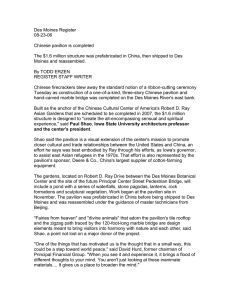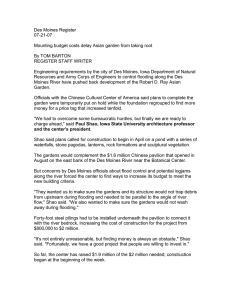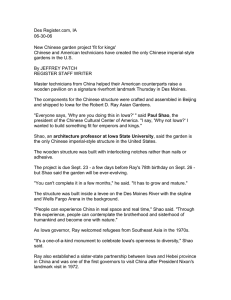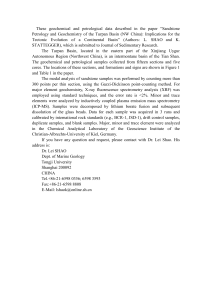Des Moines Register 10-07-07 Hunter: New pavilion a monument to diversity, perseverance
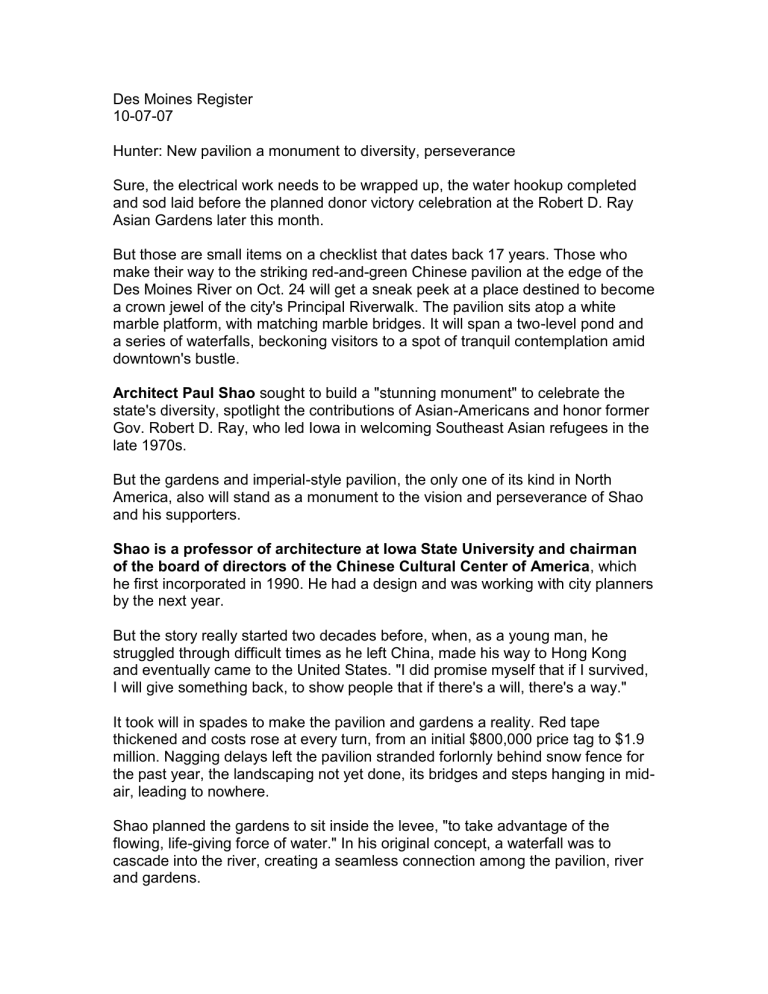
Des Moines Register
10-07-07
Hunter: New pavilion a monument to diversity, perseverance
Sure, the electrical work needs to be wrapped up, the water hookup completed and sod laid before the planned donor victory celebration at the Robert D. Ray
Asian Gardens later this month.
But those are small items on a checklist that dates back 17 years. Those who make their way to the striking red-and-green Chinese pavilion at the edge of the
Des Moines River on Oct. 24 will get a sneak peek at a place destined to become a crown jewel of the city's Principal Riverwalk. The pavilion sits atop a white marble platform, with matching marble bridges. It will span a two-level pond and a series of waterfalls, beckoning visitors to a spot of tranquil contemplation amid downtown's bustle.
Architect Paul Shao sought to build a "stunning monument" to celebrate the state's diversity, spotlight the contributions of Asian-Americans and honor former
Gov. Robert D. Ray, who led Iowa in welcoming Southeast Asian refugees in the late 1970s.
But the gardens and imperial-style pavilion, the only one of its kind in North
America, also will stand as a monument to the vision and perseverance of Shao and his supporters.
Shao is a professor of architecture at Iowa State University and chairman of the board of directors of the Chinese Cultural Center of America , which he first incorporated in 1990. He had a design and was working with city planners by the next year.
But the story really started two decades before, when, as a young man, he struggled through difficult times as he left China, made his way to Hong Kong and eventually came to the United States. "I did promise myself that if I survived,
I will give something back, to show people that if there's a will, there's a way."
It took will in spades to make the pavilion and gardens a reality. Red tape thickened and costs rose at every turn, from an initial $800,000 price tag to $1.9 million. Nagging delays left the pavilion stranded forlornly behind snow fence for the past year, the landscaping not yet done, its bridges and steps hanging in midair, leading to nowhere.
Shao planned the gardens to sit inside the levee, "to take advantage of the flowing, life-giving force of water." In his original concept, a waterfall was to cascade into the river, creating a seamless connection among the pavilion, river and gardens.
The Army Corps of Engineers required the pavilion to stand on piers to meet its requirements for building in a flood plain. Then, when ground was finally broken in 2005, the soil was weaker than expected. Plans had to be redrawn. The pilings now reach down 40 feet to bedrock. Other changes were incorporated to ensure the structure wouldn't trap debris during flooding.
Diverting river water for the ponds and waterfalls was ruled out, so water will be piped over from the Botanical Center, across Robert D. Ray Drive. Visually, from across the river, it still will look as if the river and garden ponds are one.
Delays plagued the construction process, too. Shao custom-designed the structure, which was pre-assembled in Beijing before shipment. Twenty master technicians, steeped in centuries-old Chinese building methods, were to complete the re-assembly, but their visas were denied. Eventually, three technicians were allowed to come to supervise the work of American contractors.
Between language problems and differences in cultural practices, "at the beginning, it was like pulling a cow up a tree," Shao said.
Such tensions and workaday cares will melt away for future visitors as they stroll past stone pagodas, lanterns, rock formations and bonsai-like evergreens.
(Visitors this fall won't see most of the plantings yet, which require spring seeding or transplant.)
"We're drawing people down in contact with nature, with the river," Shao said.
"When people visit the garden, they will be energized, they will be inspired, they will be revitalized by this natural force. The problem with modern society is that we're so technologically organized, rather than spending time in nature."
Completion of the gardens will mark a milestone, but not the end of the journey for Shao and other Chinese Cultural Center of America leaders. They hope eventually to build a headquarters nearby. Shao also continues to pursue the idea of bringing a pair of giant pandas to Des Moines.
Those projects will take buckets full of perseverance, too. But the gardens will offer a place for rest and renewal along the way.
EDITORIAL PAGE EDITOR CAROL HUNTER can be reached at (515) 284-8020 or chunter@dmreg.com.
